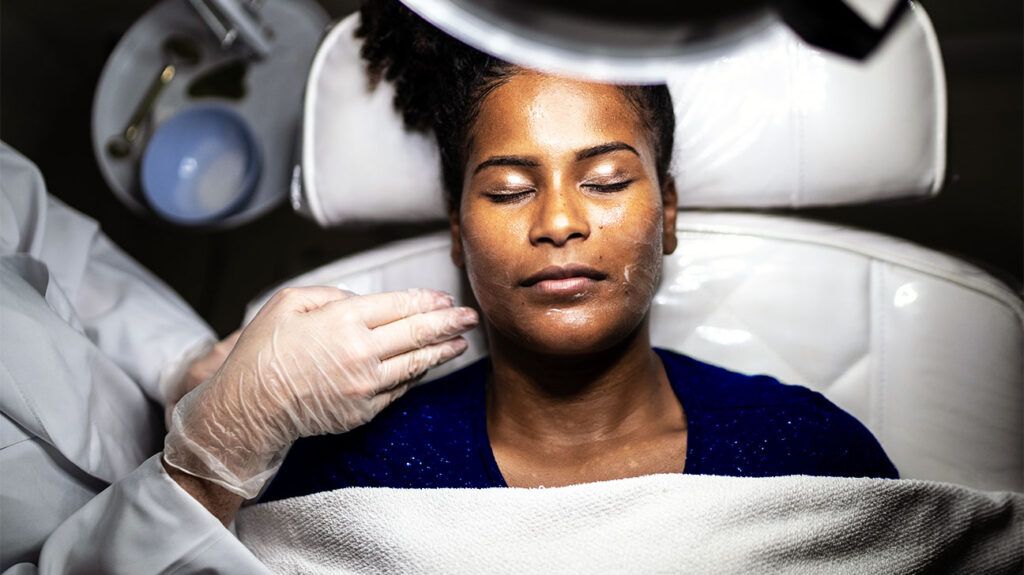Hidradenitis suppurativa (HS) is an inflammatory skin condition, where the body attacks hair follicles. Certain chemical peel ingredients may help improve HS symptoms, but more research is necessary.
A person living with the condition may experience lumps, bumps, and abscesses on their skin.
Symptoms of HS begin in the follicles but can spread to other parts of the skin. The condition is not contagious. Healthcare professionals do not know exactly what causes HS, but hormones, genes, and environmental factors may contribute to its development.
The goal of HS treatment is to prevent its progression and treat any active lesions on the skin.
Read on to learn more about chemical peels and other treatments for HS.
Dermatology resources
Visit our dedicated hub for more research-backed information and in-depth resources on dermatology.

According to the American Academy of Dermatology Association (AAD), resorcinol, an ingredient in some chemical peels, can help reduce symptoms of HS. It may help reduce inflammation and open blocked hair follicles.
A
The authors note that resorcinol could be an excellent alternative treatment option, especially as antibiotic resistance is increasing. However, this was a relatively small study based on 134 people with HS.
Research into other chemical peel ingredients for HS is limited.
People should always speak with a healthcare professional before using any chemical peels to help treat HS symptoms.
A
However, this section lists some ingredients in chemical peels that people with HS may wish to try with a doctor’s guidance.
Resorcinol
People have used resorcinol since the 19th century as a chemical peel. It has antimicrobial and anti-inflammatory properties. As time went on, researchers noted it was effective at treating abscesses. This in turn resulted in doctors suggesting resorcinol as a treatment for HS.
According to the AAD, healthcare professionals may recommend resorcinol for individuals living with mild to moderate HS.
Salicylic acid
Salicylic acid is a type of beta-hydroxy acid (BHA). BHAs may help reduce skin inflammation and are antimicrobial. Because of these properties, people with acne tend to use salicylic acid to
However, while some people suggest salicylic acid as a treatment for HS, there is not enough evidence to support its effectiveness.
Glycolic acid
Glycolic acid is a type of alpha-hydroxy acid (AHA). AHAs
However, there is not enough evidence to suggest glycolic acid peels are an effective treatment for HS.
Azelaic acid
Azelaic acid has anti-inflammatory and antimicrobial properties. Generally, doctors suggest azelaic acid creams and ointments for acne.
However, there is a lack of research to suggest that azelaic acid can effectively treat HS.
Because chemical peels remove the damaged surface layer of skin, they can cause some mild side effects, such as inflammation and swelling, which usually resolves within a few days or a week depending on the strength of the peel.
However, more serious complications of a peel include:
A person should speak with a healthcare professional before using any chemical peels to ensure they are using them correctly and performing appropriate aftercare measures. Doctors may advise that after a chemical peel, someone should:
- take measures to protect their skin from sun exposure
- not pick their skin
- keep the chemically peeled areas of the skin cool using a water spray
- moisturize their skin
The treatment of HS depends on how severe it is.
The
For mild to moderate symptoms, a doctor may suggest
Lifestyle changes
- maintaining a moderate weight
- stopping smoking
- wearing looser clothing
- keeping the skin clean and dry
- using warm compresses
Medications include:
- clindamycin
- fusidic acid
- additional antibiotics
- topical retinoids
- resorcinol
- corticosteroids
However, the Food and Drug Administration (FDA) has only approved adalimumab for HS. This drug is a biologic. These medications can reduce inflammation throughout the body.
Other treatments that may alleviate symptoms include laser hair removal and surgery to remove the lesions.
Surgical procedures include:
- Deroofing: A surgeon removes the skin covering an active abscess.
- Wide excision: A dermatologist removes a lesion and deeper skin damage.
- Laser surgery: Laser surgery can vaporize HS, though a person may need to take medication before this.
Doctors may recommend a person try using a resorcinol chemical peel for hidradenitis suppurativa (HS). Because resorcinol has both antimicrobial and anti-inflammatory properties, it may help reduce HS symptoms.
Research into the efficacy of other chemical peel ingredients for treating HS is limited. However, a person with HS may wish to speak with a healthcare professional about whether other chemical peel types may be suitable for them.
People should always speak with a doctor before using a chemical peel to ensure they are using the peel correctly and performing the appropriate aftercare measures. A healthcare professional can also recommend other treatments for HS, including lifestyle changes, other medications, and surgery.
